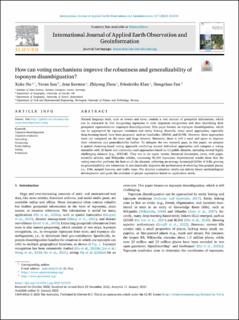| dc.description.abstract | Natural language texts, such as tweets and news, contain a vast amount of geospatial information, which can be extracted by first recognizing toponyms in texts (toponym recognition) and then identifying their geospatial representations (toponym disambiguation). This paper focuses on toponym disambiguation, which can be approached by toponym resolution and entity linking. Recently, many novel approaches, especially deep learning-based, have been proposed, such as CamCoder, GENRE, and BLINK. However, these approaches were not compared on the same and large datasets. Moreover, there is still a need and space to improve their robustness and generalizability further. To mitigate the two research gaps, in this paper, we propose a spatial clustering-based voting approach combining several individual approaches and compare a voting ensemble with 20 latest and commonly-used approaches based on 12 public datasets, including several highly challenging datasets (e.g., WikToR). They are in six types: tweets, historical documents, news, web pages, scientific articles, and Wikipedia articles, containing 98,300 toponyms. Experimental results show that the voting ensemble performs the best on all the datasets, achieving an average Accuracy@161km of 0.86, proving its generalizability and robustness. It also drastically improves the performance of resolving fine-grained places, i.e., POIs, natural features, and traffic ways. The detailed evaluation results can inform future methodological developments and guide the selection of proper approaches based on application needs. | en_US |

